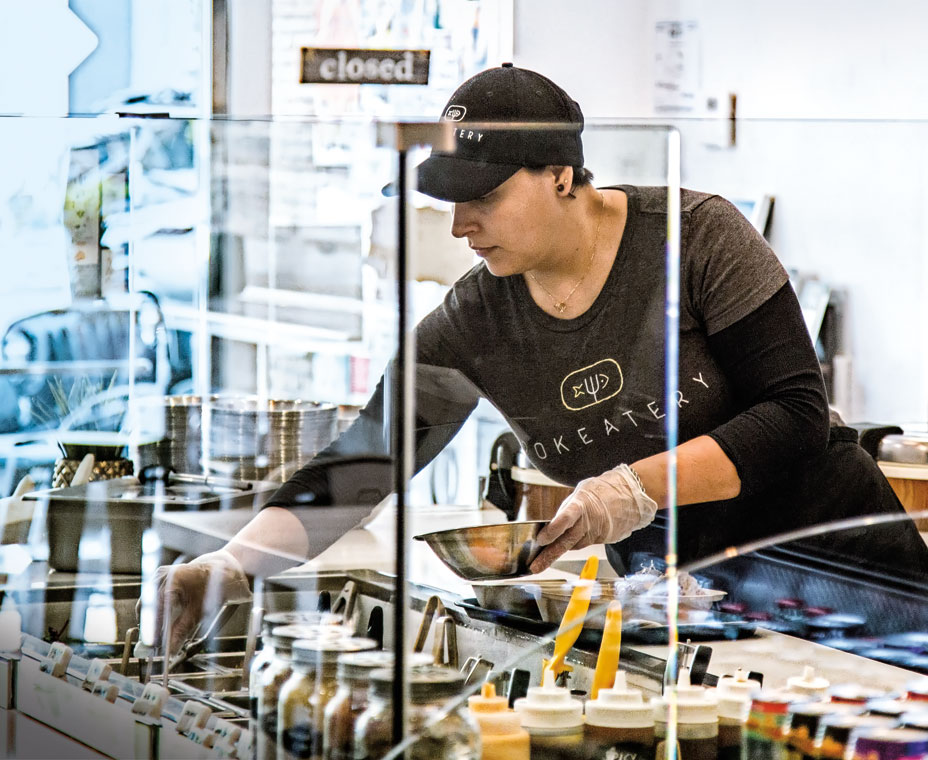Joann Chung often helped her parents with their sushi restaurants. In 2015, Chung and her husband, Derek, opened Pokeatery in San Mateo, California. Preparing raw fish for so many years has made Chung an expert in poke’s specialized food-safety requirements.
“I grew up thinking about food safety,” she says. “It was ingrained in me. I’ve noticed that a lot of poke restaurants are opened by people who don’t have experience with raw fish. That scares me a little bit.”
When working with raw fish, temperature maintenance is paramount, Chung says. While refrigerated, fish should be kept at 39–41 degrees. Pokeatery managers check their equipment and the fish on the line at least every two hours—and even more frequently on hot days. The riskiest time, Chung says, is when the raw fish is being cut because it’s exposed to room temperature. Crewmembers are trained to cut the fish quickly to minimize exposure.
According to the Food and Drug Administration, Americans suffer nearly 50 million cases of foodborne illness each year. “Nearly every perishable ingredient has the potential to develop harmful bacteria if handled improperly,” says Eric Kinniburgh, COO of Bareburger, a New York–based better-burger concept. But some items—especially fresh meat and vegetables popular with healthy quick serves—carry more risks than others. Raw fish and shellfish are among them.
There’s no raw meat at Bareburger, but temperatures never go unmonitored. The casual-dining chain augments staff checks with wireless technology that monitors cold holding temperatures and provides mobile alerts if things change.
At Oklahoma City–based Coolgreens, district manager Angelo Cipollone also requires staff to check the equipment and line temperatures every two hours to ensure that the fresh and often raw ingredients for its salads and flatbreads are safe. The health-forward fast casual maintains three logs, for food preparation, equipment temperatures, and storage. “We keep track of things by noting time and temperature,” Cipollone says. “Even the health inspector has said we only need temperature, but I know this helps guarantee what customers get is safe.”
At vegan food stall and truck Cinnamon Snail in New York City, cooling equipment—including refrigerated trucks—is not only frequently checked for temperature, but also for what is placed inside it. Fresh tofu can spoil if the water it’s submerged in isn’t changed regularly.
The fresh herbs and arugula that the concept depends on for its signature Southeast Asian–inspired tofu and seitan sandwiches and bowls can spoil quickly if placed in the wrong area of a refrigerator, says founder and chef Adam Sobel. Keeping them safe and fresh requires a careful eye, but “herbs lend an irreplaceable flavor profile. I want to bring vegan food to people who aren’t particularly on board with veganism, and I want to blow their minds,” Sobel says.
Cinnamon Snail offers primarily cooked fare because Sobel knows his clientele—often vegan skeptics—are more open to a hearty tempeh burger than a raw pizza. These vegan ingredients may require special preparation. Seitan only keeps for a week unless it’s processed, but once it’s turned into burgers, it can be stored for a month.
According to industry research, fresh produce items that are often eaten raw cause more foodborne illnesses than any other single category of food, says Katy Jones, chief marketing officer of FoodLogiQ, a software provider that helps brands track their food supply chain. Contamination and storage difficulties, as with Sobel’s herbs, can make fresh produce challenging.
One partial solution is sourcing organic produce, Bareburger’s Kinniburgh says. The rigorous environmental standards that organic farmers are held to ensure improper fertilization isn’t used in the soil, he adds.
Cooking ingredients can cut down on food-safety risks because it kills off bacteria on fresh vegetables. But cooking food still requires careful preparation, especially for fresh, unfrozen meats that can harbor bacteria like salmonella.
Sarela Herrada, director of food and beverage at Mediterranean fast casual Cava, says that sourcing raw meat is challenging because it requires immediate processing and use. “It has such a short shelf life. It’s delicate and labor intensive, but we believe it offers a unique culinary experience,” Herrada says.
Cooking the fresh meat as it’s ordered requires more labor but offers food-safety benefits. Bareburger’s meals are also cooked to order, which Kinniburgh says eliminates the need to hold pre-cooked food. “This helps dramatically in reducing unsafe conditions,” he says. Dangerous bacteria don’t have a chance to grow and fester.
Regardless of when it’s cooked, fresh meats can cross-contaminate in unexpected ways. At Coolgreens, free-range chickens are kept in a separate area, and the marinades are used for a 12-hour batch and then thrown out, Cipollone says.
Despite all precautions, operators may deem some ingredients to be too risky to use. The key is to find excellent replacements. For example, after seeing multiple recalls, Cipollone decided alfalfa sprouts—which are delicate and, he says, impossible to wash—were more trouble than they were worth. Coolgreens ultimately substituted in a watermelon radish.
“Never sacrifice the flavor or nutrition profile,” Cipollone says. “It’s easy to say, ‘Let’s just avoid the dangerous products,’ but you have to replace them. Otherwise you’re not going to have much left.”













